Wahoo Powrlink Zero dual-sided power meter pedals - long-term review
Six months after they were launched, the lollipop-shaped power meter pedals are running as sweetly as ever
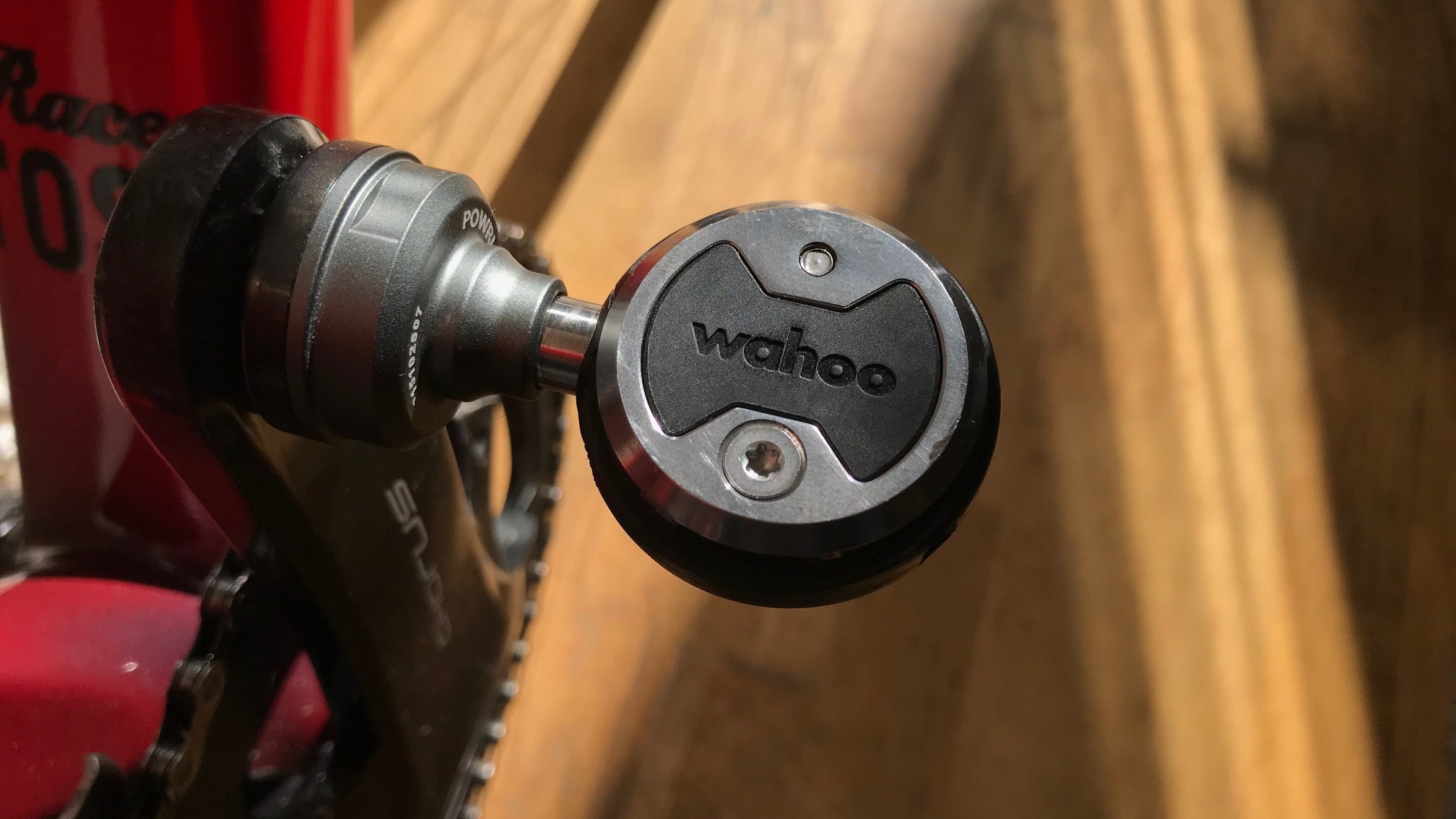
If you’re a Speedplay user you’ll love the Wahoo Powrlink Zero. It’s true it’s the only Speedplay power meter available, but Wahoo has done an incredibly thorough job of making these as good as a power meter pedal can be, which is especially impressive at the first attempt. They are durable and super reliable, both in hardware and software terms. Accuracy is spot on based on average power, with the single caveat being that the Wahoos appear to ‘smooth’ slightly, meaning sprinting peak power appears lower for short sprints.
-
+
Easy to set up
-
+
No issues at all with pairing or dropping out
-
+
Durable
-
+
Accurate
-
+
Excellent build quality
-
-
Data smoothing can lead to lower peak power reading
You can trust Cycling Weekly.

A power meter version of the iconic lollipop pedal was something Speedplay users had been looking forward to for years - and the Powrlink Zero delivers on all levels.
Wahoo acquired Speedplay in 2019 and launched an overhauled, pared back and improved version of the range in March 2021. The Powrlink Zero is based on the Speedplay Zero pedal with its stainless steel spindle and, like the standard Wahoo Speedplay pedals, is compatible with standard Speedplay cleats (included in the box).
Functionality
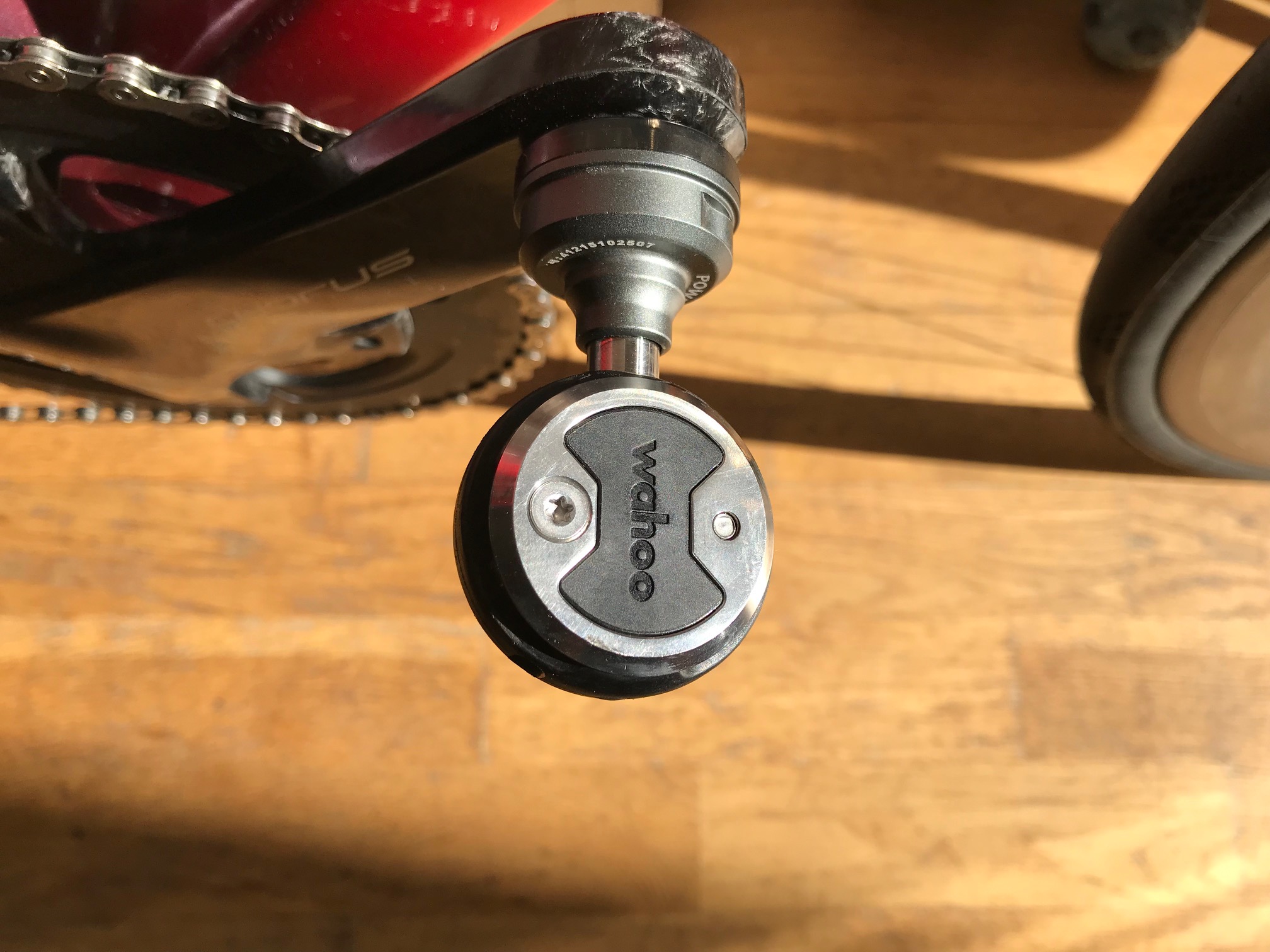
Like rival power meter pedals the Garmin Rally and Favero Assioma, the Powrlink Zero calculates cadence data as well as total power, left/right balance and other standard training metrics such as TSS (training stress) and IF (intensity factor), though it doesn’t incorporate ‘cycling dynamics’ features such as torque effectiveness and pedal smoothing.
It’s IPX7 water resistant and oval chainring compatible and has a claimed accuracy of +/-1%.
Battery life is a claimed 75 hours of ride time - which seemed to tally with my riding. I would have timed it but lost count because the battery seemed to be going on forever. Having said that, battery percentage readout on the head unit and app could be more precise; more on that later.
Garmin claims up to 120 hours for the Garmin Rally but unlike the Powrlink the Rally uses coincell rather than USB rechargeable batteries. Rechargeable is easier, cheaper and doesn't involve throwing anything away.
Charging is via an included charging cable - Y-shaped for the dual-sided option to charge both pedals simultaneously.
As for connectivity, the Powrlinks are compatible with ANT+ and Bluetooth devices and third-party apps and head units.
The electronics are housed in a pod that sits next to the crankarm, with LEDs at its base to display connection, low battery and charging status.
The Powrlink Zeros weigh a claimed 276g per pair (ours weighed less at 273g) or 250g for the left-only measurement. That’s lighter than the Gamin Rally (road version) and Favero Assiomas, neither of which come in under 300g - but, as with the regular pedals, the Speedplay cleat assembly which houses the spring trap mechanism is heavier than Shimano or Look road cleats.
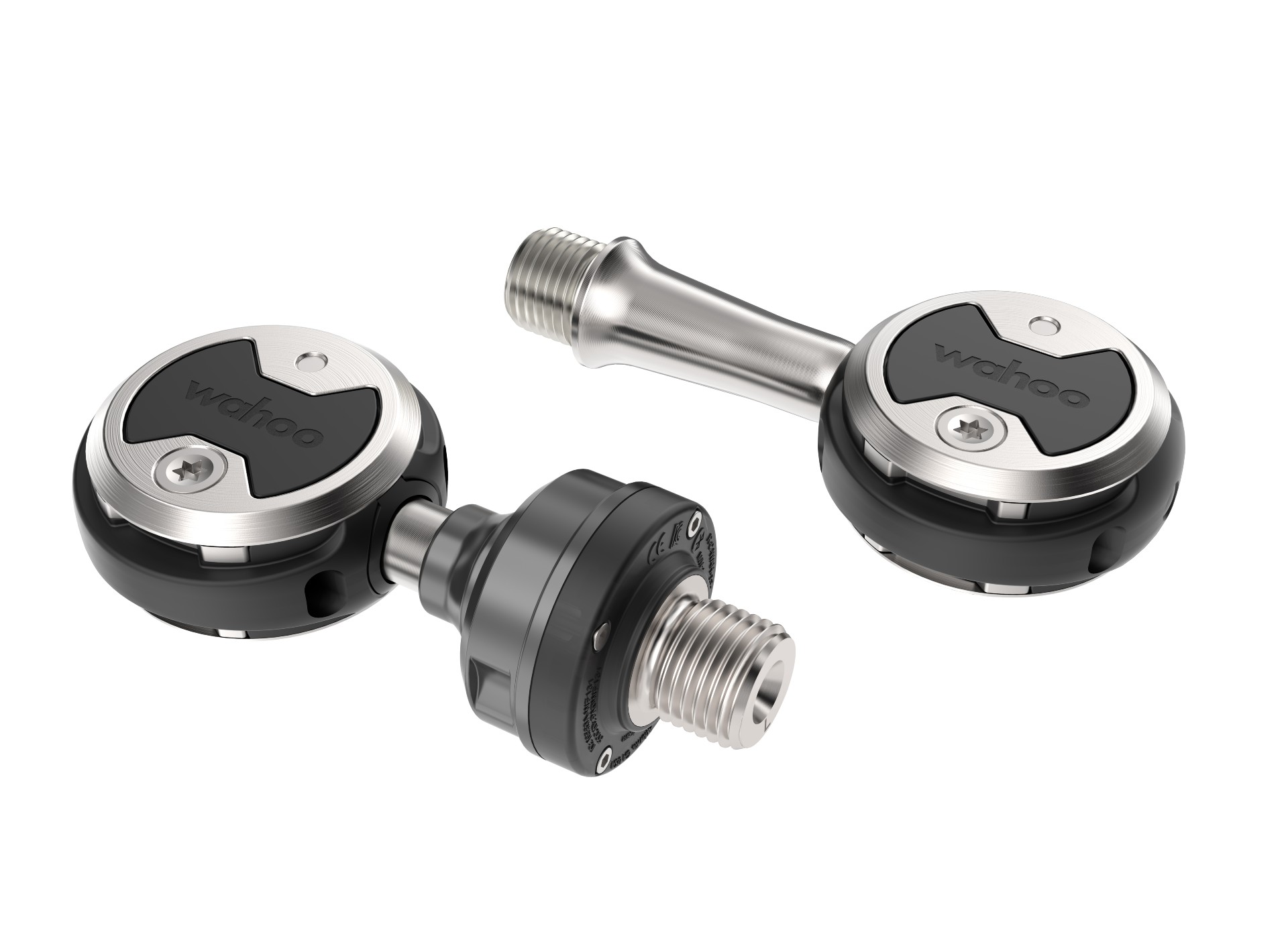
Wahoo has had to slightly increase both the stack height and spindle length in order for the rider’s shoe to clear the pod when engaging and releasing. A thicker pedal takes stack height from the 11.5mm of the standard Speedplay Zero (above) up to 13mm, which is higher than Favero (10.5mm) and Garmin Rally (12.2mm).
A longer spindle length for the Powrlink Zero (55mm compared to 53mm for the standard Speedplay Zero) increases Q factor slightly. The Garmin pedals stick with 53mm while Assioma measures 54mm, though the Assioma Shi, with a Shimano style platform, measures 64mm - a much greater deviation from standard pedals.
Setup
The Powrlink pedals come packaged in Wahoo’s trademark, super chic black, white and silver box like a pair of very expensive chocolates. As with the other recent Wahoo products, a lot of attention has been paid to the unboxing experience.
In the box are the pedals themselves - equally high-end looking - plus the charging cable and a pair of standard Wahoo Speedplay cleats.
I won’t go into cleat setup here, but suffice to say it’s quite a bit more involved than with Shimano or Look. Fortunately I had already got my Wahoo Speedplay cleats correctly positioned and float dialled in as I’m a user of the regular Wahoo Speedplay pedals.
I found I didn’t need to adjust my cleat position or float for the extra 2mm length on each spindle, and I didn’t raise my saddle by 1.5mm for the extra stack height and didn’t notice any difference.
If you’re incredibly finely tuned you might decide to move the cleat outwards by a tiny amount to compensate, but I would say most people won’t.
Wahoo says you need 1mm of clearance between the crankarm and the base of the housing which contains the LEDs: pedal washers are supplied to facilitate this. This is important. If you don’t comply you risk damaging the pods by tightening them against the crank. I had to use the washers when testing them against a Wattbike but not for modern Shimano or Campagnolo cranks.
The LEDs themselves indicate charging/charged status (green flashing/solid), low battery (red flashing) and searching/connecting/connected (blue slow flashing/fast flashing/solid). They turn off after 30 seconds to conserve battery life.
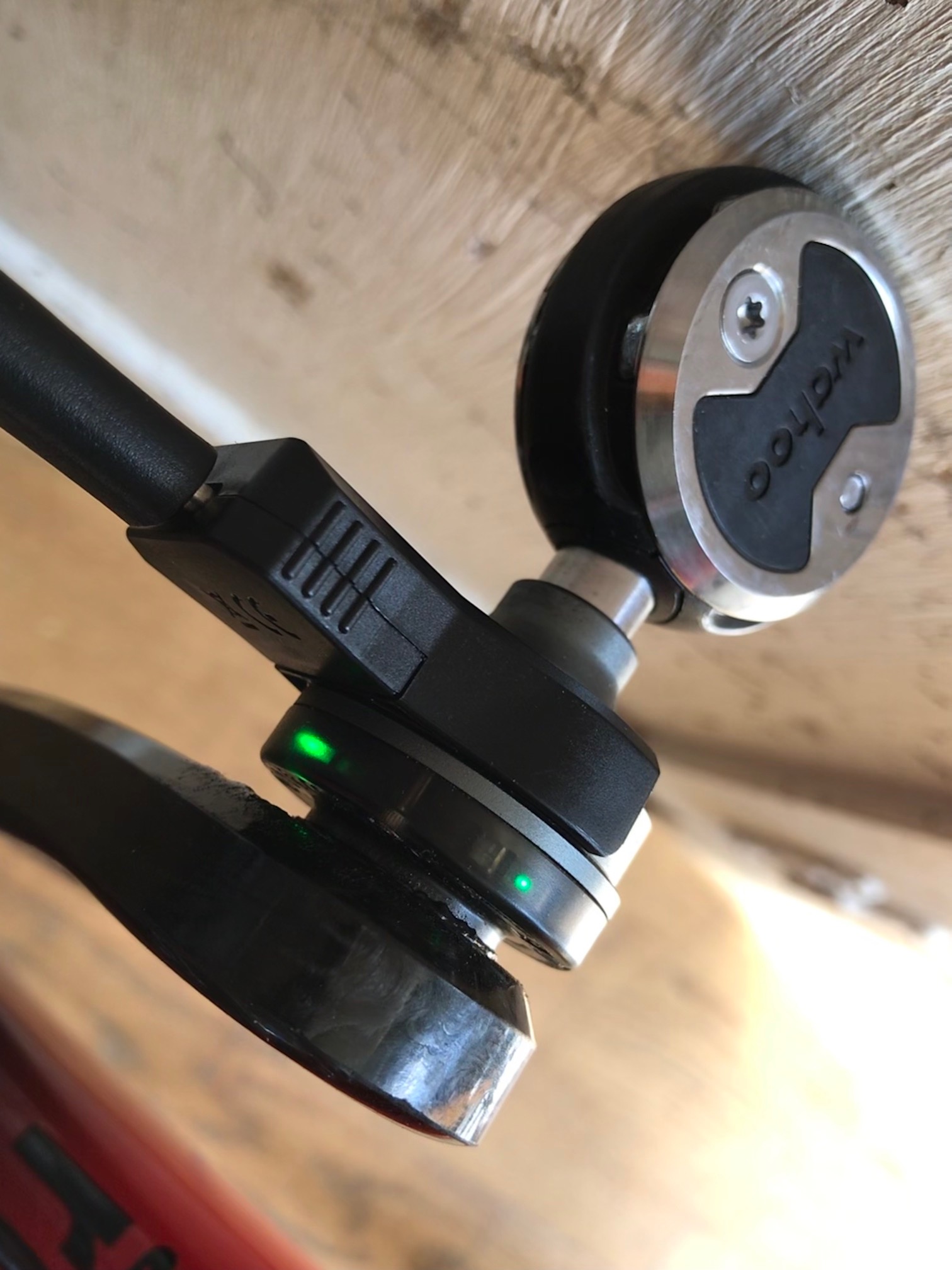
Charging is easy too - the cable is a generous two metres long and the charging clips snap onto the pedals very securely. They’re fully charged in a couple of hours.
You can set up crank length (crucial for accuracy) via the Wahoo app or via the head unit once it’s paired and also check battery life, though battery life seems to be displayed just in 10% increments rather than as a more exact number.
A head unit or GPS watch - I've used both Wahoo and Garmin - takes longer to ‘see’ the pedals than it does a heart rate monitor, but I’ve never had an instance where they have failed to pair. The blue LEDs give a good indication of where they’re at with the pairing process.
The Wahoo pedals have been criticised for not including any pedalling dynamics data such as torque effectiveness or pedal smoothness, as used by Garmin and Favero and others. The jury is still out on whether those things can be useful for training, according to Wahoo.
But post-ride analysis on the Wahoo app includes left/right balance (with the dual sided version), average and max power, TSS, normalized power, power curve and time in zones and that’s enough for me.
Obviously if you're using it with a Garmin head unit you'll get the data on Garmin Connect.
I do enjoy Wattbike’s pedalling effectiveness score (PES), but that’s nice to have rather than essential. For me the basic metrics are enough for road riding.
Accuracy
Wahoo claims +/-1% accuracy, but remember that figure relates to how accurate the pedals are against themselves rather than an absolute number.
Although Wahoo says “the pedals automatically calibrate to the ambient temperature at the start of your ride” it’s crucial to ‘settle’ them before using them for the first time or on a different bike. I found they underread quite significantly if you don't.
In order to ensure proper mechanical seating Wahoo tells you to perform 2-3 “quick standing track starts” (pedalling very hard in a big gear from a standstill. My pedals arrived before the official launch with the instructions on the app not yet live, so I know from experience that unless you do this you may think you’ve lost 20 or 30 watts overnight.
Although the pedals can auto-calibrate, Wahoo recommends doing a manual zero offset before each ride.
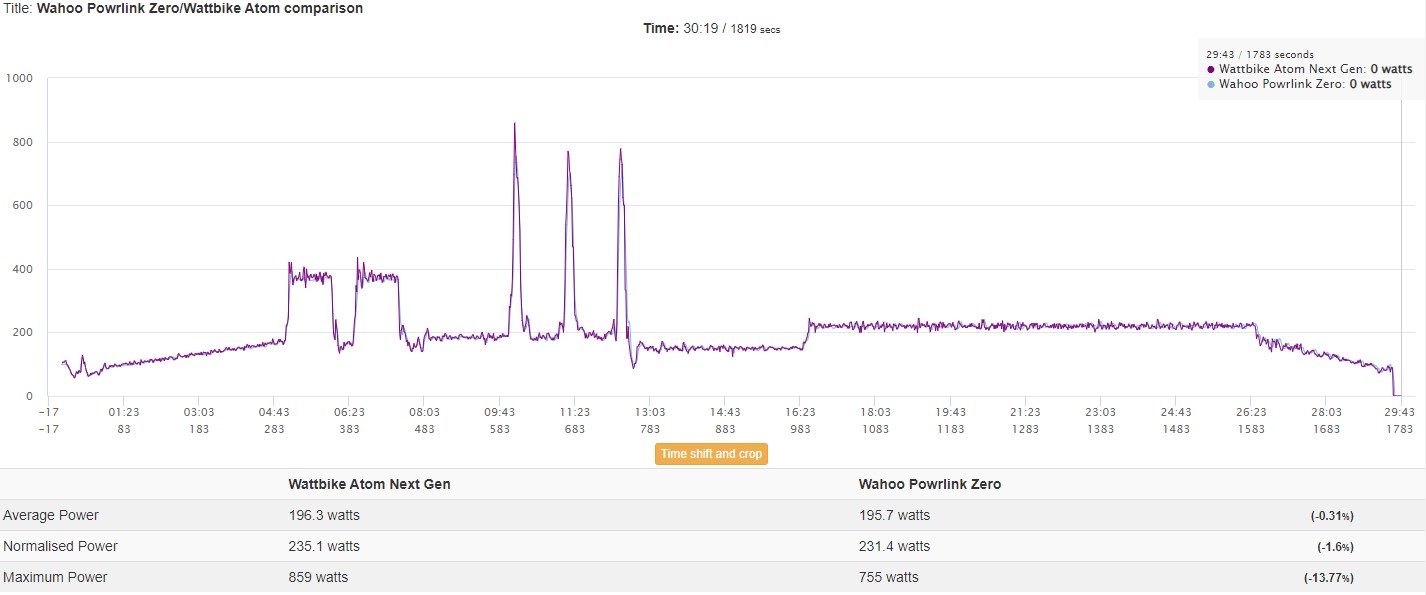
Jon's Short Mix on Zwift: Wahoo blue, Wattbike purple
Once settled and calibrated, I tested the Wahoo pedals against my Wattbike Atom Next Generation that I know to be accurate.
The pedals were within two watts of the Wattbike for ‘Jon’s Short Mix’ on Zwift, which is a half-hour workout with a bit of everything. For the steady 10-minute effort the Wattbike and the pedals both averaged 220 watts. For the three sprint efforts the Powrlink Zero pedals recorded slightly less than the Wattbike.
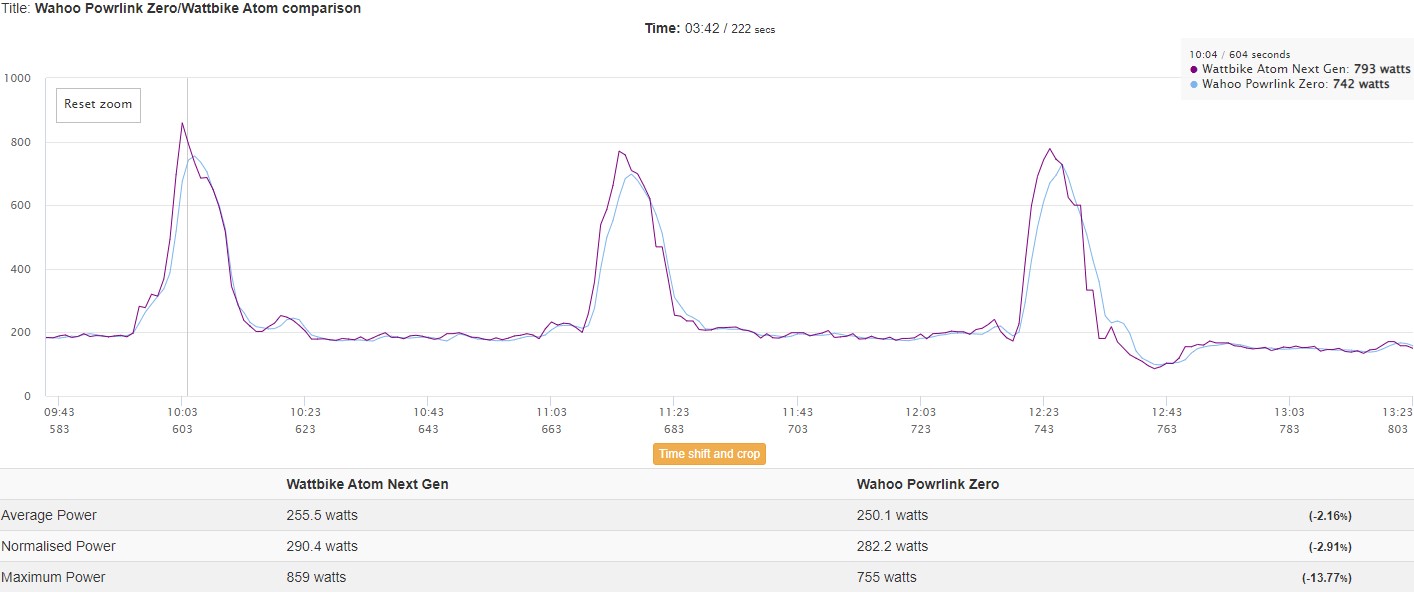
Zooming in on the ZwiftPower graph I created to compare them, the Wattbike during the steady 10-minute effort looks as if it’s spiking downwards below the Wahoo pedals as well as above them (see below), whereas the Wahoo pedals follow a smoother line - but they both end up with an average that’s within a watt or two of each other.
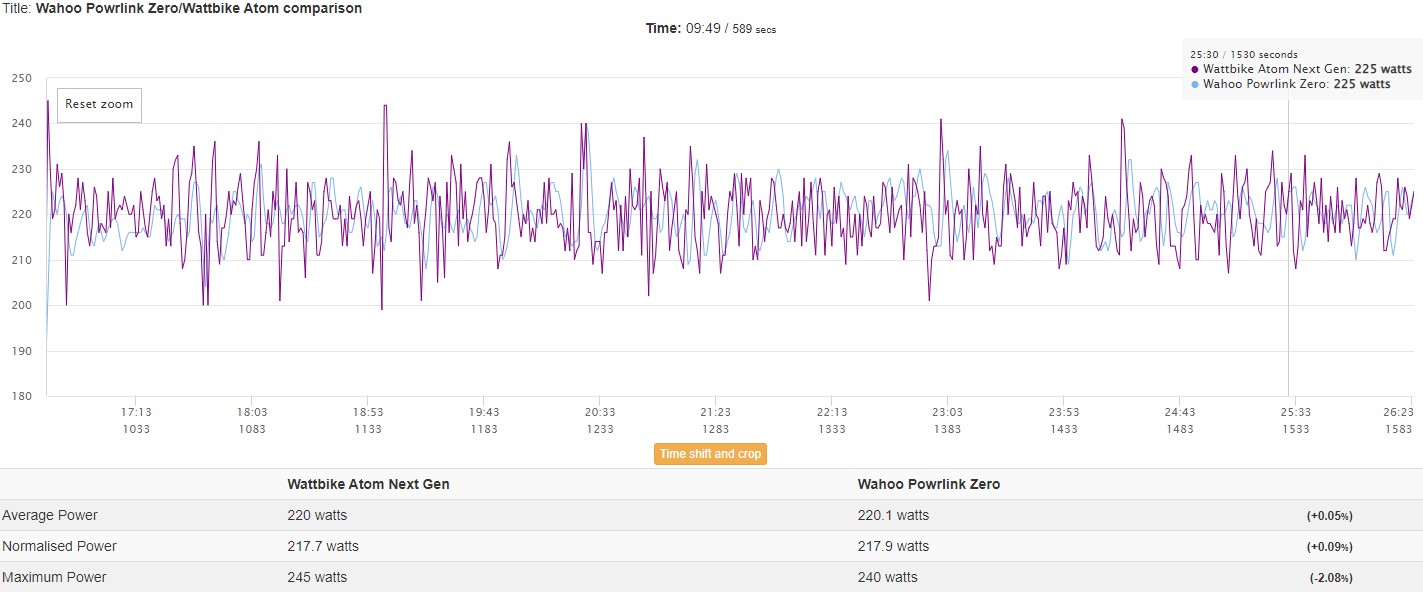
My own conclusion is that the variation in the sprints is down to the pedals’ strain gauges measuring the power in a different way from the Wattbike’s load cell measurement system but it could also be that at the start of a sprint in erg mode the Wattbike’s resistance ramps up quickly before settling down, hence the higher reading for peak power sprints.
Additionally, in erg mode the Wattbike is constantly making small adjustments. If I could pedal smoothly at 500 watts I suspect the Wahoo pedals would read the same as the Wattbike, as they did with the 220-watt effort.
In summary, compared to a trusted smart bike, I’m satisfied with the Wahoo pedals’ accuracy.
Value
The single-sided Powrlink Zero retails at £549.99/$649.99 which is on a par with the single-sided Garmin Rally RS/RK100 (£579.99) but more expensive than the Favero Assioma Uno (£449).
The dual-sided Powrlink Zero we have on test here has an RRP of £849.99/$999.99 (compared to £969.99 for the Garmin Rally RS/RK200 and £699 for the Assioma Duo).
I’ve used the Wahoo Powrlink pedals on at least five bikes in the six months since they arrived and am 100% happy with the way they’ve been wearing - or rather haven’t been wearing.
Since the new Wahoo design uses a stainless steel rim that mates with the cleat, they’re looking almost as good as new after six months: all you can see is a slight scuff where the cleat spring engages. The bearings are beautifully smooth.
Conclusion
Other power meter pedals had teething problems with durability and battery connection issues but it’s hard to fault anything at all with the Wahoo Powrlinks. They are incredibly easy to set up and use, build quality is superb, there are no pairing issues and accuracy is spot on based on average power, with the single caveat being that the Wahoos appear to ‘smooth’ slightly, meaning sprinting peak power appears lower for short sprints.
Overall this is a high-quality product that's fairly priced compared to the competition and comes highly recommended.
Specs
- Weight 273g dual sided
- Q-factor/stack height: 55mm/13mm
- Connectivity: ANT+ and Bluetooth
- Battery: Rechargeable lithium
- Battery life 75 hours
- Features: Total power, cadence, temperature, automatic calibration, IPX7 water resistance, LED indicators

Thank you for reading 20 articles this month* Join now for unlimited access
Enjoy your first month for just £1 / $1 / €1
*Read 5 free articles per month without a subscription

Join now for unlimited access
Try first month for just £1 / $1 / €1
Get The Leadout Newsletter
The latest race content, interviews, features, reviews and expert buying guides, direct to your inbox!
Simon Smythe is a hugely experienced cycling tech writer, who has been writing for Cycling Weekly since 2003. Until recently he was our senior tech writer. In his cycling career Simon has mostly focused on time trialling with a national medal, a few open wins and his club's 30-mile record in his palmares. These days he spends most of his time testing road bikes, or on a tandem doing the school run with his younger son.
-
 'This is the marriage venue, no?': how one rider ran the whole gamut of hallucinations in a single race
'This is the marriage venue, no?': how one rider ran the whole gamut of hallucinations in a single raceKabir Rachure's first RAAM was a crazy experience in more ways than one, he tells Cycling Weekly's Going Long podcast
By James Shrubsall Published
-
 Full Tour of Britain Women route announced, taking place from North Yorkshire to Glasgow
Full Tour of Britain Women route announced, taking place from North Yorkshire to GlasgowBritish Cycling's Women's WorldTour four-stage race will take place in northern England and Scotland
By Tom Thewlis Published
-
 Positive signs for UK bike industry as Halfords cycling sales grow
Positive signs for UK bike industry as Halfords cycling sales growRetailer admits that the impact of Donald Trump's tariffs remains to be seen
By Tom Thewlis Published